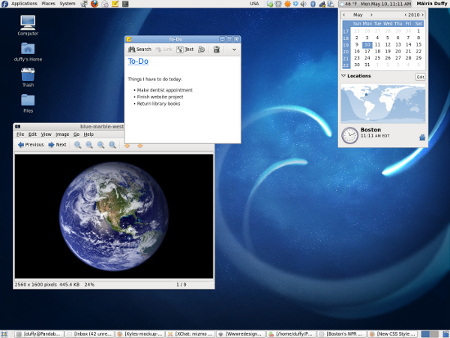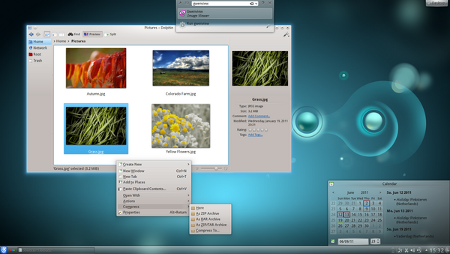Linux creator calls for GNOME fork
Aug 4, 2011 — by Eric Brown — from the LinuxDevices Archive — 3 viewsLinux creator Linus Torvalds weighed in on the debate over the controversial GNOME 3.0 desktop environment, recommending that someone fork the “unholy mess.” Meanwhile, version 4.7 of the rival KDE environment has arrived with new touchscreen and OpenGL 2.0 support, and Netflix is said to be working on a Linux port.
Long before the leading Linux desktop environment GNOME arrived in a 3.0 version in April, long-time GNOME users have been grumbling about the radical changes. The dissatisfaction only increased since GNOME 3.0's debut in the beta of Fedora 15 and continued with the Fedora 15 final.
We mention Fedora because no other major Linux distro has yet to make the switch. To avoid it, Canonical gambled on its own controversial Unity UI layer in Ubuntu 11.04, and the Ubuntu-flavored Linux Mint 11 opted for the earlier GNOME 2.32.1.
 Now Linux creator and kernel overseer Linus Torvalds (pictured), has stepped in to call the "crazy" GNOME 3.0 an "unholy mess," and has recommended a fork of the GNOME Foundation project.
Now Linux creator and kernel overseer Linus Torvalds (pictured), has stepped in to call the "crazy" GNOME 3.0 an "unholy mess," and has recommended a fork of the GNOME Foundation project.
As reported by Steven J. Vaughan-Nichols on ZDNet, Torvalds joined in a Google+ discussion about Fedora to call for a GNOME fork. He also revealed that he has switched to Xfce.
"Could you also fork gnome, and support a gnome-2 environment?" Torvalds pleaded. "I want my sane interfaces back. I have yet to meet anybody who likes the unholy mess that is gnome-3."
Torvalds' displeasure with GNOME 3.0 was no secret, as was revealed in his Linux 3.0 announcement, when he compared it with the similarly controversial release of KDE 4.0 in early 2008. (As noted by Susan Linton in a historical take on Linus' latest tirade in Ostatic, Linus hated KDE 4.0 so much that he switched back to GNOME.)
GNOME 3: where the sun don't shine
Torvalds does not mince words in his latest GNOME 3.0 comments. After noting the Linux desktop UI layer's widely detailed rendering problems, he heads straight for the heart of the matter: a dumbed down, yet convoluted UI.

Fedora 15 with GNOME 3
(Click to enlarge)
"Why can't I have shortcuts on my desktop?" Torvalds wonders. "Why can't I have the expose functionality? Wobbly windows? Why does anybody sane think that it's a good idea to have that 'go to the crazy activities' menu mode?"
After referring to the process for adding a new terminal window "just crazy crap" and another example of "head up the arse" behavior by GNOME, Torvalds adds, "Seriously. I have been asking other developers about gnome3, they all think it's crazy."
Indeed, while you can find many vocal supporters of Canonical's controversial Unity, GNOME 3.0 boosters seem few and far between. As Intel's open source honcho Dirk Hohndel notes in the same online discussion, "We had a little event in Portland last week where we brought about 20 top Linux developers together. ZERO people in the room were using Gnome3."
Like Torvalds, Hohndel, who is also unhappy with "the latest flavor of KDE," says he is switching to Xfce.
KDE 4.7 arrives with improved touch, mobile device support
The "latest flavor" referred to be Hohndel would likely be KDE 4.7, which emerged quietly late last week six months after the release of KDE 4.6. While KDE 4.7 is a relatively minor overhaul compared to GNOME 3.0, the number two desktop environment has revamped its Plasma Desktop and Plasma Netbook Workspaces to add touchscreen support and improved Oxygen icons, says the KDE community.

KDE 4.7 with overhauled Plasma experience
(Click to enlarge)
On the application front, Dolphins has been enhanced and offers a new search interface, and the Kontact groupware package has been ported to Akonadi and now offers KMail 2. In addition, DigiKam 2.0 now features face detection and recognition functionality, says the community.
The new release has been given a closer look by Ryan Paul in an Ars Technica hand-on published earlier this week. In addition to the above features, Paul notes some "important enhancements on the backend." These are said to include enhancements to KDE's Phonon multimedia layer, which adds a VLC-based backend.
In addition, KDE's Strigi and Nepomuk file indexing and metadata storage systems received improvements "that will boost stability and offer more functionality to applications that leverage desktop metadata," writes Paul.
Led by the new OpenGL 2.0 support, KDE 4.7 "brings a number of noteworthy improvements," he concludes.
Netflix finally heading for Linux?
Finally, in the "we hope this is not just a tease because our hearts have been broken too many times before" department, some Netflix engineers tipped a new Linux version in the making. The news, which we should note falls short of an official announcement, was revealed by Jack Wallen of TechRepublic on Aug. 1.
Writes Wallen: "A fellow Linux zealot, Benjamin Kerensa, contacted me to inform me that, while attending OSCON, he spoke with a pair of Netflix engineers who spilled some pretty cool beans. Those beans were that, within the next twelve months, Netflix streaming will finally arrive on the Linux platform."
Wallen says the long lead time for the port of the streaming video app is due to the fact that it's "not a top priority."
Well, we've been here before.
But wait — there's more. Another contact told Wallen that a Chromium plugin is in the works that will enable Netflix streaming on Linux — and presumably much sooner than the official Netflix port will arrive. Yet, when Wallen looked for it on the Chromium site, all he found was a Chrome OS plug-in under development, not a more general Chromium browser release.
Wallen also notes that it is very unlikely the official Netflix port will be open source, which "will rub many in the Linux community the wrong way." To that, he adds, "I'd rather have Netflix streaming to my desktop — closed source or no."
This article was originally published on LinuxDevices.com and has been donated to the open source community by QuinStreet Inc. Please visit LinuxToday.com for up-to-date news and articles about Linux and open source.